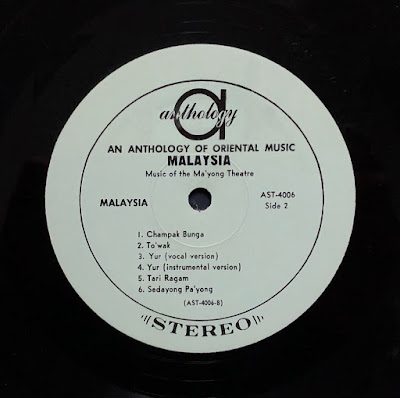The Music of Malaysia – Ma'Yong Theatrical Music from Kelantan – Anthology AST 4006, recorded by William P. Malm, 1968 (LP)
“A typical Mak Yong performance opens with an offering followed by dances, acting and music, as well as improvised monologues and dialogues. A single story can be presented over several consecutive nights in a series of three-hour performances.”**
The Mak Yong orchestra’s stark three-stringed rebab bowed lute (replaced with a double reed serunai on track B5), a pair of gendang double-headed barrel drums, tetawak hanging gongs, voices and wailing chorus, weave delicate, otherworldly, abstract sonorities. The last track (B6), with an unidentified accompanying ensemble and a shaman, takes us back to the ceremonial-shamanistic roots of this multifaceted art. “The basic form of the music is a dialogue between the shaman-dancer and the rebab player who sings and plays intermittently, when the "possessed" shaman carries on a conversation with the spirit transferred from the ill person to the puteri [shaman].”*
*Liner notes by William P. Malm
Cet enregistrement oublié de musique Ma'Yong (ou Mak Yong), qui associe danse et art dramatique traditionnels du Kelantan au nord de la Malaisie, offre un aperçu fascinant du « mélange de traditions autochtones et islamiques, qui font partie intégrante du riche patrimoine musical malaisien ».* Jouissant du statut de théâtre royal grâce au mécénat du sultanat du Kelantan jusque dans les années 1920, le Mak Yong est également associé à des rituels de guérison à travers le chant, la danse de transe et la possession autrefois pratiqués dans les zones rurales.
« Une représentation de Mak Yong commence par des offrandes, suivies de danses, de théâtre, de musique, de monologues et de dialogues improvisés. Les séances durent trois heures et peuvent se répéter plusieurs soirées de suite selon l’histoire choisie. »**
L’orchestre Mak Yong comprend un luth rebab à trois cordes (remplacé par un serunai à double-anche sur la piste B5), une paire de tambours gendang, des gongs suspendus tetawak, des voix et des chœurs, qui tissent des sonorités délicates, abstraites, et éthérées. Le dernier morceau (B6), avec un orchestre non identifié et un chaman, nous ramène aux sources cérémoniales-chamaniques de cet art aux multiples facettes. « La forme de base de la musique est un dialogue entre le danseur-chaman et le joueur de rebab qui chante et joue par intermittence, au moment où le chaman possédé engage un dialogue avec l'entité invisible transférée de la personne malade au chaman puteri. »
*Notes de la pochette de disque par William P. Malm
*Notes de la pochette de disque par William P. Malm
A1 – Instrumental Overture / Sedayong Tongget and Barat Anjor
A2 – Instrumental Overture / To'wak and Barat Patak
A3 – Introductory Dance Music / Mengadap Rebab
A4 – Journey Song / Kijang Emas
A5 – Circle Dance Song / Sedayong Ma'yong
B1 – Lyrical Song / Charnpak Bunga
B2 – To'wak Song / sung by male vocalist
B3 – Clown Song / Yur
B4 – Instrumental version / Yur
B5 – Dance piece / Tani Ragam
B6 – Sedayong Pa'yong sung by a puteri / A shamanic version of Ma’Yong music
PERFORMING ARTISTS
Actresses and Singers: Halimah bind Abu Bakar; Fatimah binti Abu Bakar; Mainunah binti Umat; Minah binti Ma'Hassan; Emas bind Awang; Minah binti Yusuf; and Kelsom binti Lembet.
Comedians and drum and gong players: Abdullah bin Awang; Osman bin Harum; and Yusoh bin Awang.
Musicians: Ahmad bin Awang, rebab bowed lute; Ahmad bin Senik and Daud bin Sallah, gendang double-headed barrel drums.
Puteri shaman: Anak Gajah from Kampong Kadok. Unidentified accompanying ensemble (B6).
Recordings and photographs by musicologist William P. Malm (b. 1928) – renowned for his publications on Japanese traditional music – in Kok Pasir and Jalawat, July 1968.
Our other Malaysian music share:
The Senoi of Malacca – Bärenreiter Musicaphon BM 30 L 2561, 1963 here
The photographs of musicians below are from Ngac Him and Jacques Brunet in Malaisie - Musique Traditionnelle - CBS 80934, 1975 (LP):
Raja Hassan Raia Ibrahim, rebab bowed-lute master
Please help me purchase important traditional records to pursue my global
curation project and share the best finds with you on this blog:













No comments:
Post a Comment